Finding General Polynomials from Their Zeroes
Purplemath
On the previous page, we learned how to find a quadratic when given its zeroes. Quadratics are just one sort of polynomial. We can apply the exact same technique to finding general polynomials from their zeroes, too.
Content Continues Below
Affiliate
Advertisement
How do you find a polynomial from given solutions?
To write out a polynomial with given solutions, we follow these steps:
- Take a given solution, x = a.
- Convert the solution equation into a factor equation; namely, x − a = 0.
- Drop the "equals zero" part to get just the factor, x − a.
- Repeat steps (1) through (3) for each of the given solutions.
- Multiply all the factors together, and simplify for the general form of the polynomial (that is, the polynomial multiplied by the generic constant "a").
- If they give you an off-axis point, use that to find the value of the constant a, and multiply through.
In other words, finding polynomials from their roots (solutions, zeroes) is exactly the same as finding quadratics from their roots, other than that you'll be multiplying together more than just the two factors.
What is an example of finding a polynomial from its roots?
- Find the polynomial with integer coefficients having roots at 3, −5, and −½, and passing through the point (−1, 16).
To find the factors, I subtract the roots over to the other side of the "equals" sign, and then drop the "equals zero" part, so my factors are:
x − 3
x − (−5) = x + 5
x − (−½) = x + ½
To find the general form of the polynomial, I multiply all the factors back together:
(x − 3)(x + 5)(x + ½)
= (x2 + 2x − 15)(x + ½)
= x3 + 2.5x2 − 14x − 7.5
This polynomial has decimal coefficients, but I'm supposed to be finding a polynomial with integer coefficients. So I'll first multiply through by 2 to get rid of the fractions:
2(x3 + 2.5x2 − 14x − 7.5)
2x3 + 5x2 − 28x − 15
Then my general form of the polynomial is a(2x3 + 5x2 − 28x − 15). Plugging in the one off-axis point they gave me, I get:
a(2x3 + 5x2 − 28x − 15) = y
a((2(−1)3 + 5(−1)2 − 28(−1) − 15) = 16
a(−2 + 5 + 28 − 15) = 16
a(16) = 16
a = 1
It doesn't often happen with this type of problem, but sometimes the multiplier a will turn out to be 1, in which case nothing more needs to be done. The polynomial they're looking for is:
2x3 + 5x2 − 28x − 15
Content Continues Below
- Find the polynomial having rational coefficients and having roots at −1, and 4, and passing through (3, −4).
First, I take note of their specification that this polynomial will have "rational" coefficients. This means that it's okay if I end up with fractions.
Two of the factors are easy to find. If I have zeroes at x = −1 and x = 4, then I must have factors of x − (−1) = x + 1 and x − 4.
The other solution is messy, what with the square root in it. Since they specified that the polynomial has rational (that is, fractional or integer) coefficients, I know I can't leave that square root by itself; I have to find its pair that the Quadratic Formula created.
In the Quadratic Formula, the ± symbol is right in front of the square root, so the pair for the solution must be .
(Warning: The pair to the given root is *not* or . Be careful with that sign change; the sign change occurs only between the two terms, right in front of the square-root part. There are no other sign changes.)
Then the remaining factors are and .
When I go to multiply my factors together, I'm going to multiply these messy factors first. It can be very helpful to do this multiplication work "vertically", the way you probably learned back when you studied how to multiply polynomials.
Note: You can check that this multiplication is correct by solving x2 − 4x + 1 = 0 in the Quadratic Formula, and verifying that the solutions are indeed and .
Now I multiply in the other factors:
(x2 − 4x + 1)(x + 1)(x − 4)
(x2 − 4x + 1)(x2 − 3x − 4)
x4 − 7x3 + 9x2 + 13x − 4
Then the general form of the polynomial is:
a(x4 − 7x3 + 9x2 + 13x − 4)
To solve for that constant, I'll plug in the point that they gave me:
a(x4 − 7x3 + 9x2 + 13x − 4) = y
a((3)4 − 7(3)3 + 9(3)2 + 13(3) − 4) = −4
a(81 − 189 + 81 + 39 − 4) = −4
a(8) = −4
a = −0.5
Then the polynomial they started with was:
−0.5(x4 − 7x3 + 9x2 + 13x − 4)
Maybe I should take the one-half through the parentheses, but that'll give me all sorts of fractions. That's why I quit when I did.
You can check your work by doing a quick graph. If the x-intercepts of your polynomial match the (real) zeroes they gave you and the given point is on the graph (or displayed in the TABLE of values), then you know your answer is correct.
entering the polynomial into the calculator

checking the graph: all the roots are there

verifying: the point is listed as being on the graph

If they give you a complex root, the pairing process for finding the remaining roots works the same way, because you know that complexes are generated by negatives inside the square root in the Quadratic Formula. (You can't check the complex roots on a graph, of course, since complex roots don't graph as x-intercepts. But you can still confirm the real roots.)
What is an example of finding a polynomial from its complex roots?
- Find the polynomial having roots at −2i and 3 + i, and passing through the point (3, −13).
Okay; they've given me two complex-valued roots. These complex roots are always generated (by the Quadratic Formula) in pairs, so the full listing of the roots will be −2i, 2i, 3 + i, and 3 − i. (Note how I only changed the sign on the part of the root that came from the square root in the Quadratic Formula.)
Then the factors were x − (−2i) = x + 2i, x − 2i, x − (3 + i) = x − 3 − i, and x − (3 − i) = x − 3 + i. Since the Quadratic Formula spits the roots out in pairs, it's generally easiest to multiply the roots back together in pairs. Here's the first multiplication:
And here's the second multiplication:
Multiplying the pairs of factors gave me two polynomials, each of which is a factor of whatever was the original polynomial (namely, the polynomial that I need to find). To get the entire polynomial, I need to multiply these two polynomials together. When I do so, I get:
(x2 − 6x + 10)(x2 + 4)
= x4 − 6x3 + 14x2 − 24x + 40
This is the polynomial before I check whether there was a number divided out of each of the terms of the original polynomial. Using the extra point they gave me, I plug the coordinates into the equation, and solve for the value of any numerical factor of the original polynomial:
a( x4 − 6x3 + 14x2 − 24x + 40 ) = −13
a((3)4 − 6(3)3 + 14(3)2 − 24(3) + 40) = −13
a(81 − 162 + 126 − 72 + 40) = − 13
a(13) = −13
a = −1
Then the desired polynomial is:
−x4 + 6x3 − 14x2 + 24x − 40
Affiliate
That's all there is to this topic. You take the roots they give you, and subtract each of them from x; this gives you your factors. If you have a messy root (with a square root or a complex number), you create the paired root, and subtract it from x too. Multiply all your factors together, starting with any messy pairs first. Then you either multiply the whole thing by some generic "I don't know if you divided something off" constant a, or, if they give you an extra point on the curve, you solve for the value of the multiplier a.
About the only mistake students make in this process is in forming the factors: always remember to subtract the zeroes from x; don't add them. You're converting the zeroes to factors by un-solving for x:
x = a
−a = −a
x − a = 0
And remember that you can always check your work by setting your polynomial answer equal to zero and finding the roots. As long as your solutions match the ones you were given in the first place, you must be at least close to the right answer.
URL: https://www.purplemath.com/modules/fromzero2.htm
Select a Course Below
Standardized Test Prep
Homeschool Math
© 2024 Purplemath, Inc. All right reserved. Web Design by ![]()




